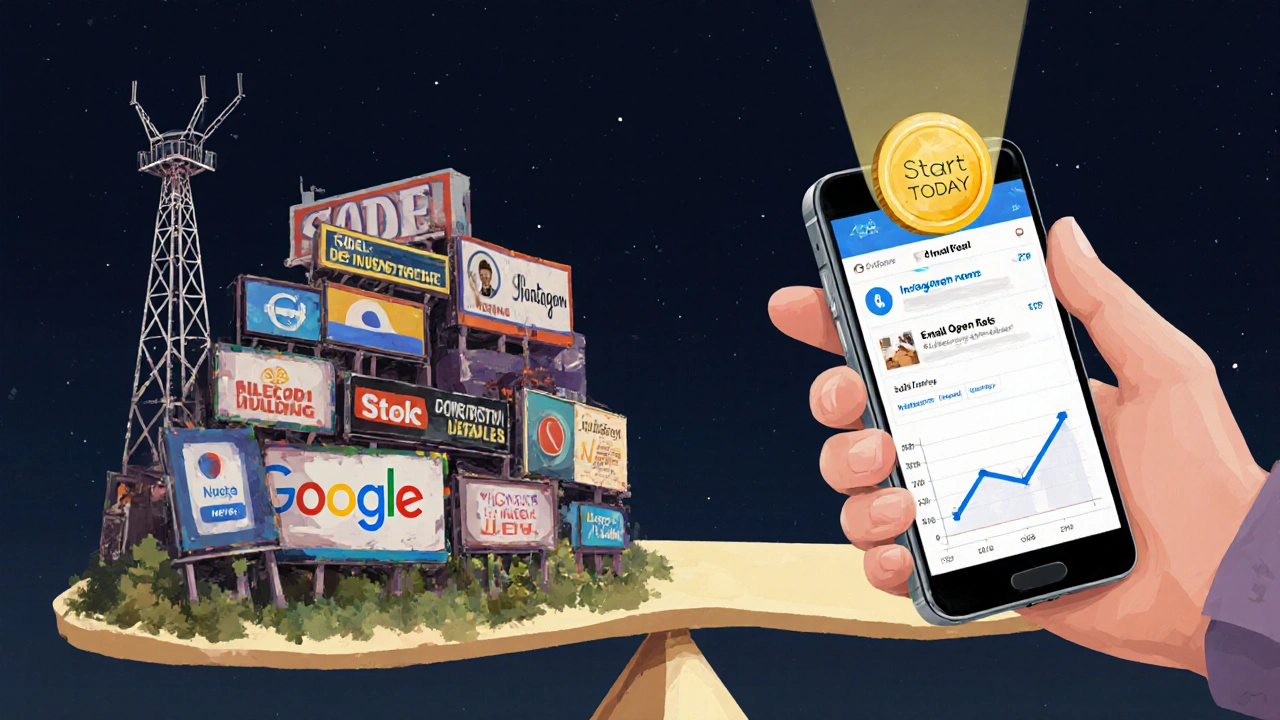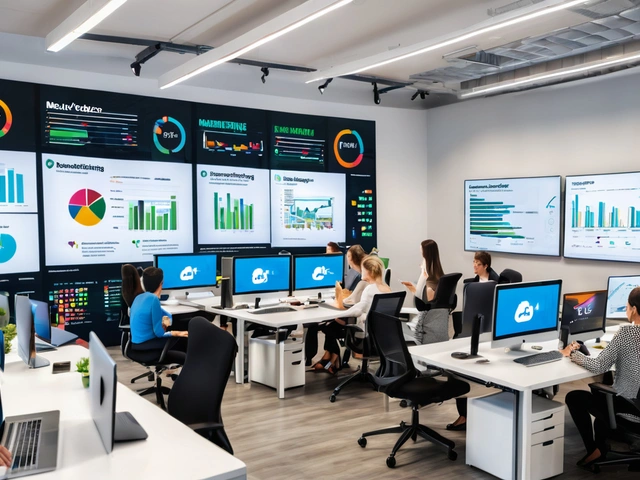Digital Marketing ROI Calculator
Calculate your potential return on investment from digital marketing campaigns. Based on your budget, customer value, and conversion rates.
Five years ago, a small bakery in Brisbane could only reach people within a 5-kilometer radius. Today, that same bakery sells custom cakes to customers in Sydney, Melbourne, and even London-all because of digital marketing. It’s not magic. It’s strategy. And it’s working for businesses of every size, in every industry.
What Digital Marketing Actually Does
Digital marketing isn’t just posting on Instagram or running Google Ads. It’s the entire system of finding, reaching, and keeping customers using online tools. That includes email lists, search engines, social media, websites, videos, and even text messages. The goal? To turn strangers into buyers-and buyers into loyal fans.
Unlike traditional ads that shout at everyone, digital marketing listens. It tracks what people click, how long they stay, and what they buy. Then it adjusts. A local plumber in Brisbane doesn’t waste money on billboards. He runs targeted Facebook ads to homeowners aged 35-55 who’ve searched for “leaky faucet repair near me.” That’s precision. That’s efficiency.
Why It’s a Game Changer for Small Businesses
Before digital marketing, small businesses needed big budgets to compete. You needed TV ads, radio spots, print flyers-expensive, hard to measure, and easy to ignore.
Now? A single person with a laptop can run a global campaign for under $50 a month. Take a handmade jewelry seller in regional Queensland. She uses Pinterest to show her pieces, Instagram Stories to share behind-the-scenes videos, and Google Shopping to list her products. In six months, she went from 10 sales a month to 300. No warehouse. No staff. Just smart digital moves.
Here’s the truth: digital marketing levels the playing field. If you know your audience and use the right tools, you can outperform corporations with ten times your budget.
The Four Core Pillars That Actually Work
Not all digital marketing tactics are equal. Some are flashy but useless. Others quietly drive sales. Here are the four that deliver real results:
- Search Engine Optimization (SEO) - When someone searches for “best organic skincare Australia,” you want your website to show up first. SEO isn’t about stuffing keywords. It’s about creating helpful content, getting real backlinks from trusted sites, and making your site load fast. A Brisbane-based yoga studio improved its Google ranking by 72% in four months just by writing detailed guides on stress relief and breathing techniques.
- Content Marketing - People don’t want to be sold to. They want to be helped. Blog posts, videos, downloadable checklists, and email newsletters that solve real problems build trust. A financial advisor in Gold Coast grew his email list to 12,000 by offering a free “Debt Payoff Planner” PDF. He didn’t ask for money until month three.
- Social Media Marketing - It’s not about posting daily. It’s about showing up where your customers are, and being useful. A pet grooming salon in Adelaide uses TikTok to post 15-second clips of dogs getting spa treatments. Their follower count jumped from 800 to 45,000 in eight months. Bookings? Up 200%.
- Email Marketing - Still the highest ROI channel. People who sign up for your emails are already interested. A local bookstore in Brisbane sends weekly emails with personalized book recommendations based on past purchases. Their repeat customer rate is 68%. That’s not luck. That’s data.

How Data Turns Guesswork Into Decisions
Digital marketing is the first type of marketing where you can see exactly what’s working. You don’t guess if your ad worked-you know. Google Analytics tells you how many people clicked. Meta Insights shows you which post got the most shares. Email platforms tell you who opened, who clicked, and who bought.
A fitness coach in Brisbane used to run Facebook ads with random images and vague headlines. She got 30 clicks a week. Then she started testing. One ad said: “Tired of workouts that don’t change your body?” Another: “Lose 8kg in 12 weeks-no gym required.” The second one converted 5x better. She scaled it. Her monthly revenue jumped from $2,000 to $11,000.
That’s the power of data. It removes emotion. It replaces guesswork with proof.
Common Mistakes That Kill Results
Many businesses think digital marketing is easy. It’s not. Here are the three mistakes most make:
- Trying to be everywhere - Posting on TikTok, Instagram, LinkedIn, and YouTube at the same time? That’s not strategy. That’s burnout. Focus on one or two platforms where your customers actually hang out.
- Ignoring mobile - Over 60% of searches happen on phones. If your website takes more than 3 seconds to load, or looks broken on small screens, you’re losing customers before they even see your offer.
- Not following up - You get a lead from a Facebook ad. Then you disappear. The average person needs 7 touchpoints before they buy. Send an email. Retarget them with an ad. Offer a free consultation. Don’t just wait.

What’s Next? The Trends That Matter in 2025
Digital marketing isn’t standing still. Here’s what’s changing right now:
- AI-powered personalization - Tools like ChatGPT and Google’s AI overviews can now write product descriptions, answer customer questions, and even suggest email subject lines. But the best marketers use AI to help-not replace-their human touch.
- Video is dominating - Short-form video (TikTok, Reels, YouTube Shorts) is now the #1 way people discover products. Even B2B companies are using 30-second clips to explain services.
- Privacy-first marketing - With cookies disappearing and Apple’s privacy updates, businesses can’t track users like before. The solution? Build your own audience. Collect emails. Encourage sign-ups. Own your customer list.
- Local SEO is booming - “Near me” searches grew 150% since 2020. If you have a physical location, you need a Google Business Profile, real reviews, and location-specific content.
Where to Start (Even If You’re Overwhelmed)
You don’t need a team. You don’t need a big budget. You just need to start with one thing.
- Claim your Google Business Profile. It’s free. It’s essential.
- Pick one social platform where your customers are. Focus there for 90 days.
- Create one piece of helpful content-a blog post, a video, a downloadable guide.
- Ask five past customers for a quick review or testimonial.
- Set up a simple email list using Mailchimp or ConvertKit. Offer a freebie in exchange for their email.
Do those five things. Wait 30 days. Then check your numbers. You’ll be surprised.
Digital Marketing Isn’t Optional Anymore
Businesses that ignore digital marketing aren’t just falling behind. They’re disappearing. Customers aren’t waiting for you to show up in a physical store. They’re searching online. If you’re not there, they’ll find someone who is.
The good news? You don’t need to be a tech expert. You don’t need to understand algorithms. You just need to understand your customers-and use the tools that put you where they are.
Digital marketing isn’t a trend. It’s the new way business gets done. And the businesses that win? The ones who start today.
Is digital marketing only for big companies?
No. In fact, small businesses benefit the most. Digital marketing levels the playing field. A local café with a $200 monthly budget can outperform a chain with a $50,000 ad spend if they use targeted Facebook ads, Google Maps listings, and email newsletters correctly. The key isn’t money-it’s focus.
How long does it take to see results from digital marketing?
It depends. Paid ads (like Facebook or Google Ads) can bring traffic in hours. SEO and content marketing take longer-usually 3 to 6 months to show strong results. But once they work, they keep working. Email marketing often shows results in 2 to 4 weeks. The fastest way to see results? Combine paid ads with a strong email list. That combo delivers sales within weeks.
Do I need to be on every social media platform?
Absolutely not. Being everywhere spreads you too thin. A bakery should focus on Instagram and Facebook-visual platforms where people share food. A B2B software company should be on LinkedIn. A fitness trainer might thrive on TikTok and YouTube Shorts. Pick one or two platforms where your customers spend time-and do them well.
What’s the most important metric in digital marketing?
It’s not likes, shares, or followers. It’s customer acquisition cost (CAC) and lifetime value (LTV). If you spend $50 to get a customer who spends $300 over time, you’re winning. If you spend $200 for a customer who only buys once, you’re losing. Track those two numbers. Everything else is noise.
Can I do digital marketing myself?
Yes, if you’re willing to learn. Many small business owners run their own digital campaigns successfully. Start with free tools: Google Business Profile, Canva for graphics, Mailchimp for email, and Meta Business Suite for ads. Spend 5 hours a week learning and testing. In 3 months, you’ll know more than most hired marketers.
If you’re ready to grow, start with your Google Business Profile today. It’s free. It’s simple. And it’s the first step most successful businesses took.





